Video Forgery Detection in Video Surveillance: A Report
VerifiedAdded on 2022/08/08
|6
|1047
|22
Report
AI Summary
This report delves into the increasing use of video surveillance and its importance as evidence, while also addressing the growing problem of video forgery. It explores the two main types of video surveillance, digital and analog, with a focus on the cost-effectiveness and wider viewing angles of digital systems. The report outlines the benefits of video surveillance, including its acceptance in courts and the planning of effective network architecture. It then defines the problem of video surveillance forgery, detailing how it affects video surveillance, forensic investigations, law enforcement, and defamation. The report discusses the types of video tampering, including spatial and temporal tampering, and explores active and passive approaches to video forgery detection, such as digital watermarking and the analysis of video properties. The report references several sources from 2019 and 2020, highlighting the contemporary relevance of this topic.
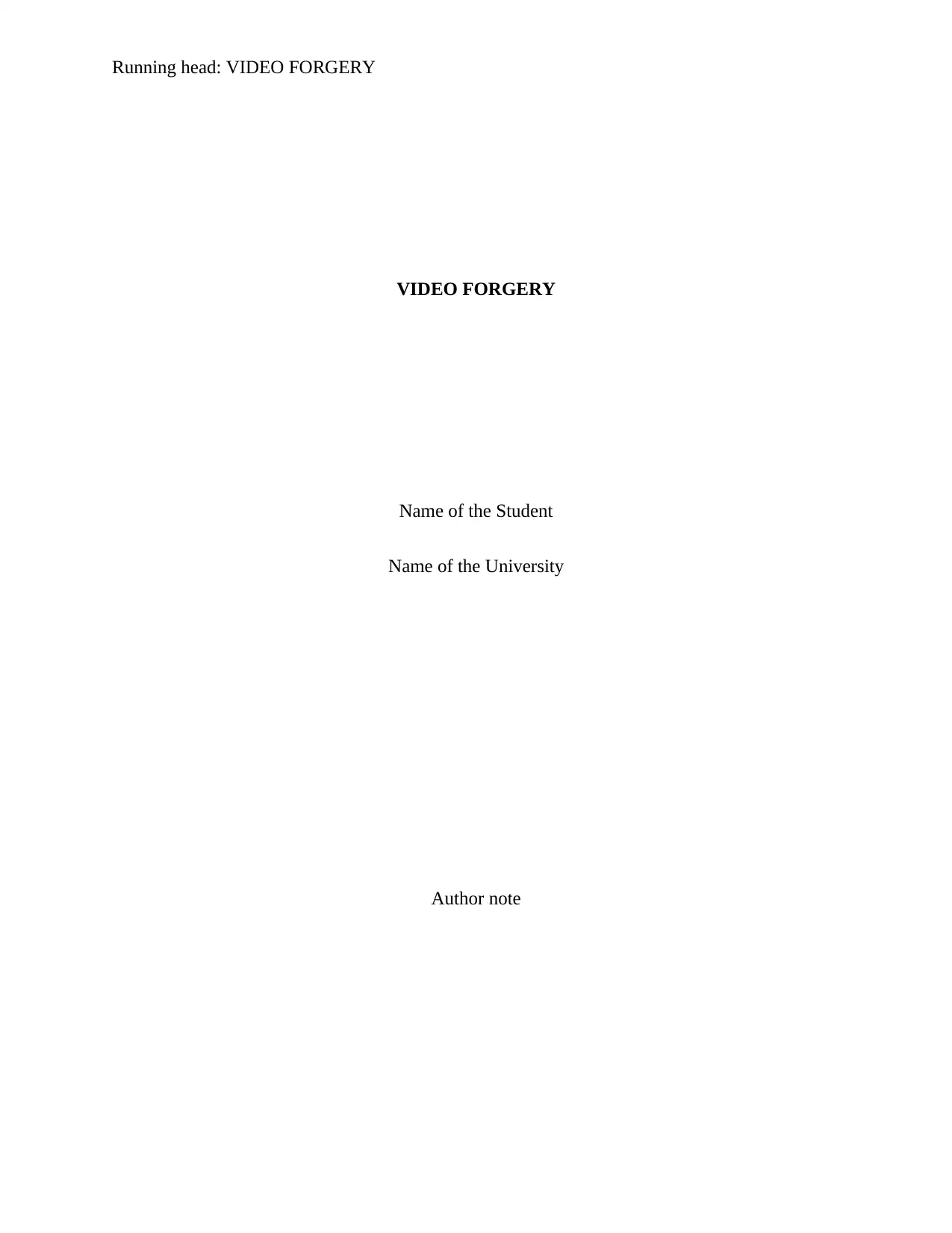
Running head: VIDEO FORGERY
VIDEO FORGERY
Name of the Student
Name of the University
Author note
VIDEO FORGERY
Name of the Student
Name of the University
Author note
Paraphrase This Document
Need a fresh take? Get an instant paraphrase of this document with our AI Paraphraser
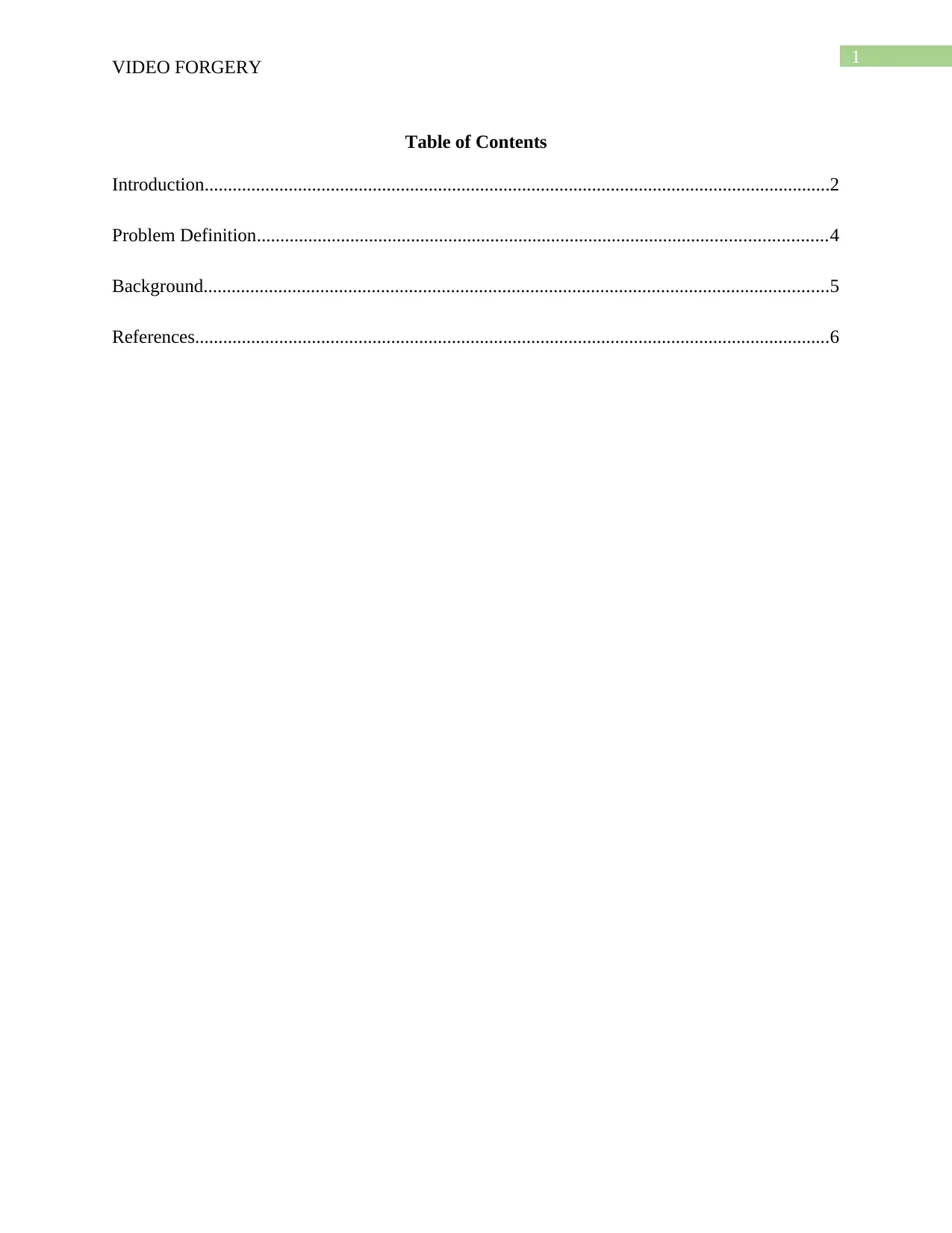
1
VIDEO FORGERY
Table of Contents
Introduction......................................................................................................................................2
Problem Definition..........................................................................................................................4
Background......................................................................................................................................5
References........................................................................................................................................6
VIDEO FORGERY
Table of Contents
Introduction......................................................................................................................................2
Problem Definition..........................................................................................................................4
Background......................................................................................................................................5
References........................................................................................................................................6
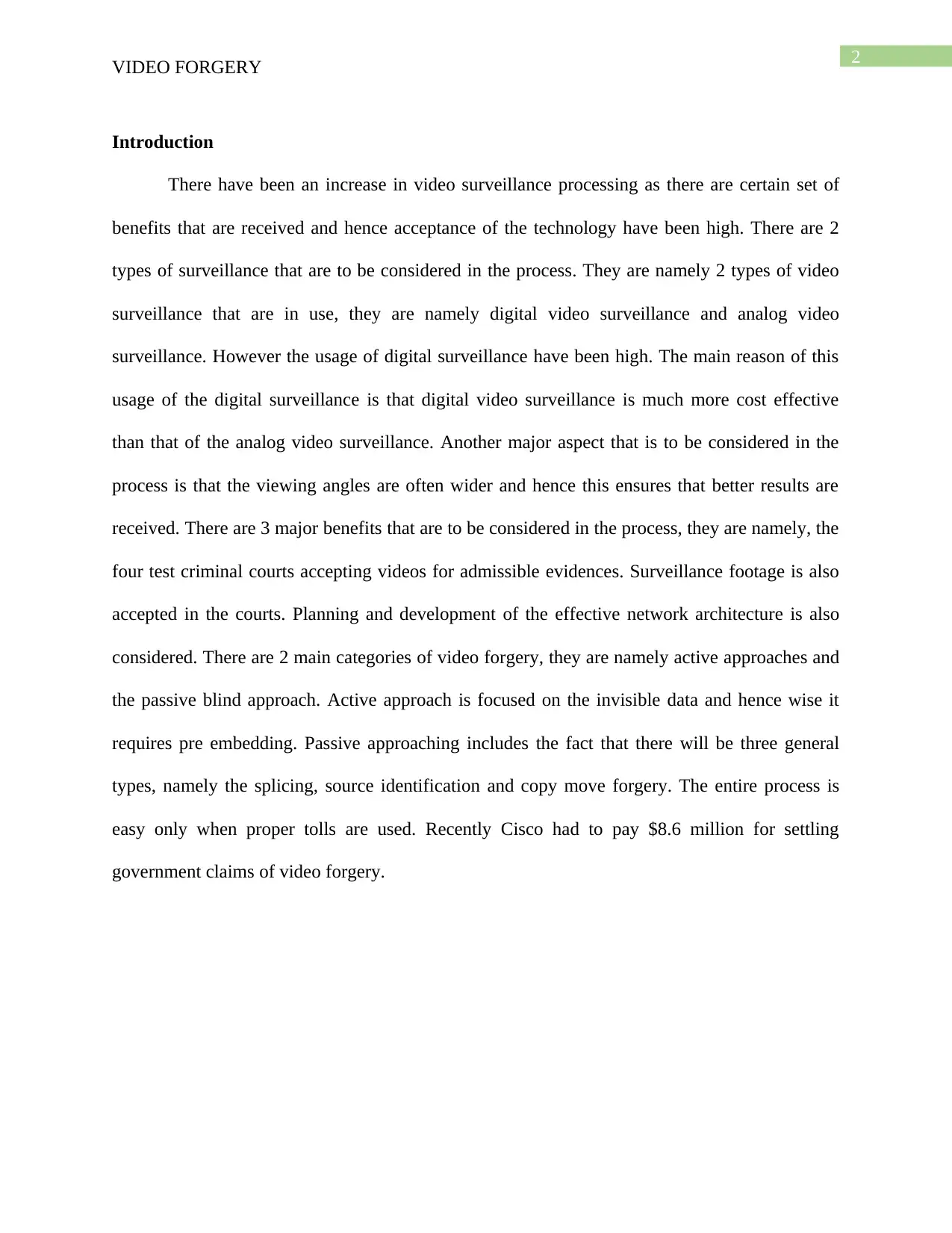
2
VIDEO FORGERY
Introduction
There have been an increase in video surveillance processing as there are certain set of
benefits that are received and hence acceptance of the technology have been high. There are 2
types of surveillance that are to be considered in the process. They are namely 2 types of video
surveillance that are in use, they are namely digital video surveillance and analog video
surveillance. However the usage of digital surveillance have been high. The main reason of this
usage of the digital surveillance is that digital video surveillance is much more cost effective
than that of the analog video surveillance. Another major aspect that is to be considered in the
process is that the viewing angles are often wider and hence this ensures that better results are
received. There are 3 major benefits that are to be considered in the process, they are namely, the
four test criminal courts accepting videos for admissible evidences. Surveillance footage is also
accepted in the courts. Planning and development of the effective network architecture is also
considered. There are 2 main categories of video forgery, they are namely active approaches and
the passive blind approach. Active approach is focused on the invisible data and hence wise it
requires pre embedding. Passive approaching includes the fact that there will be three general
types, namely the splicing, source identification and copy move forgery. The entire process is
easy only when proper tolls are used. Recently Cisco had to pay $8.6 million for settling
government claims of video forgery.
VIDEO FORGERY
Introduction
There have been an increase in video surveillance processing as there are certain set of
benefits that are received and hence acceptance of the technology have been high. There are 2
types of surveillance that are to be considered in the process. They are namely 2 types of video
surveillance that are in use, they are namely digital video surveillance and analog video
surveillance. However the usage of digital surveillance have been high. The main reason of this
usage of the digital surveillance is that digital video surveillance is much more cost effective
than that of the analog video surveillance. Another major aspect that is to be considered in the
process is that the viewing angles are often wider and hence this ensures that better results are
received. There are 3 major benefits that are to be considered in the process, they are namely, the
four test criminal courts accepting videos for admissible evidences. Surveillance footage is also
accepted in the courts. Planning and development of the effective network architecture is also
considered. There are 2 main categories of video forgery, they are namely active approaches and
the passive blind approach. Active approach is focused on the invisible data and hence wise it
requires pre embedding. Passive approaching includes the fact that there will be three general
types, namely the splicing, source identification and copy move forgery. The entire process is
easy only when proper tolls are used. Recently Cisco had to pay $8.6 million for settling
government claims of video forgery.
⊘ This is a preview!⊘
Do you want full access?
Subscribe today to unlock all pages.

Trusted by 1+ million students worldwide
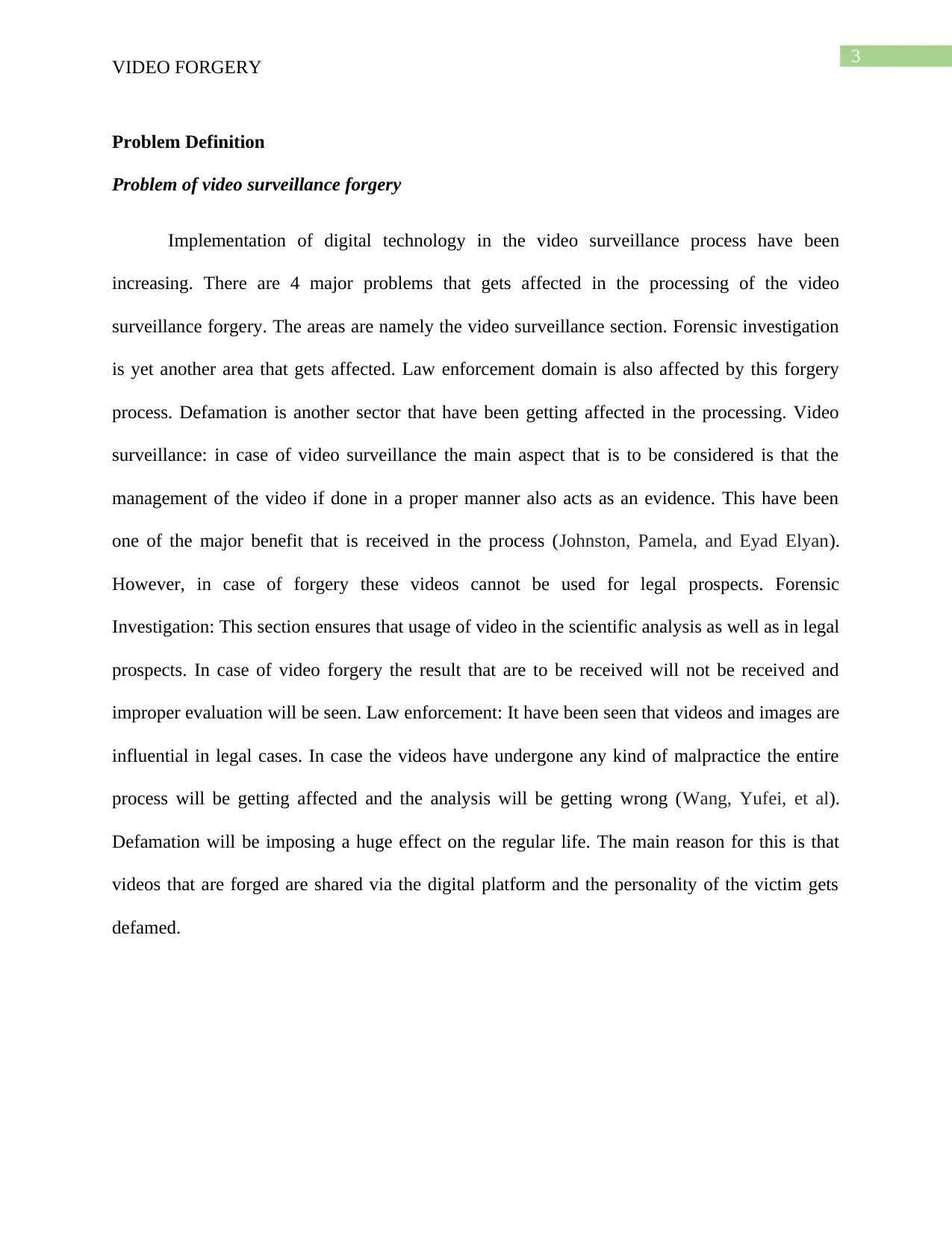
3
VIDEO FORGERY
Problem Definition
Problem of video surveillance forgery
Implementation of digital technology in the video surveillance process have been
increasing. There are 4 major problems that gets affected in the processing of the video
surveillance forgery. The areas are namely the video surveillance section. Forensic investigation
is yet another area that gets affected. Law enforcement domain is also affected by this forgery
process. Defamation is another sector that have been getting affected in the processing. Video
surveillance: in case of video surveillance the main aspect that is to be considered is that the
management of the video if done in a proper manner also acts as an evidence. This have been
one of the major benefit that is received in the process (Johnston, Pamela, and Eyad Elyan).
However, in case of forgery these videos cannot be used for legal prospects. Forensic
Investigation: This section ensures that usage of video in the scientific analysis as well as in legal
prospects. In case of video forgery the result that are to be received will not be received and
improper evaluation will be seen. Law enforcement: It have been seen that videos and images are
influential in legal cases. In case the videos have undergone any kind of malpractice the entire
process will be getting affected and the analysis will be getting wrong (Wang, Yufei, et al).
Defamation will be imposing a huge effect on the regular life. The main reason for this is that
videos that are forged are shared via the digital platform and the personality of the victim gets
defamed.
VIDEO FORGERY
Problem Definition
Problem of video surveillance forgery
Implementation of digital technology in the video surveillance process have been
increasing. There are 4 major problems that gets affected in the processing of the video
surveillance forgery. The areas are namely the video surveillance section. Forensic investigation
is yet another area that gets affected. Law enforcement domain is also affected by this forgery
process. Defamation is another sector that have been getting affected in the processing. Video
surveillance: in case of video surveillance the main aspect that is to be considered is that the
management of the video if done in a proper manner also acts as an evidence. This have been
one of the major benefit that is received in the process (Johnston, Pamela, and Eyad Elyan).
However, in case of forgery these videos cannot be used for legal prospects. Forensic
Investigation: This section ensures that usage of video in the scientific analysis as well as in legal
prospects. In case of video forgery the result that are to be received will not be received and
improper evaluation will be seen. Law enforcement: It have been seen that videos and images are
influential in legal cases. In case the videos have undergone any kind of malpractice the entire
process will be getting affected and the analysis will be getting wrong (Wang, Yufei, et al).
Defamation will be imposing a huge effect on the regular life. The main reason for this is that
videos that are forged are shared via the digital platform and the personality of the victim gets
defamed.
Paraphrase This Document
Need a fresh take? Get an instant paraphrase of this document with our AI Paraphraser
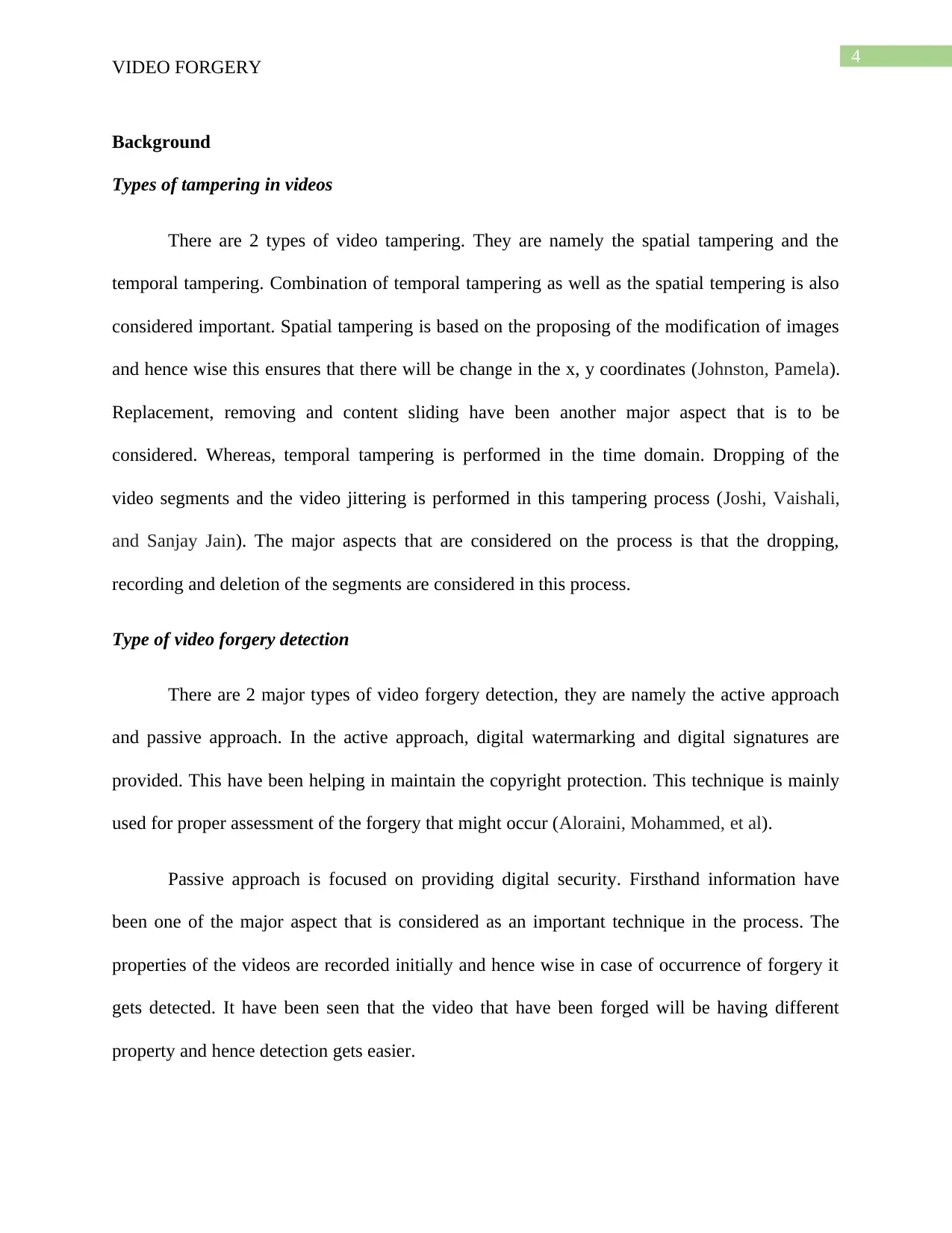
4
VIDEO FORGERY
Background
Types of tampering in videos
There are 2 types of video tampering. They are namely the spatial tampering and the
temporal tampering. Combination of temporal tampering as well as the spatial tempering is also
considered important. Spatial tampering is based on the proposing of the modification of images
and hence wise this ensures that there will be change in the x, y coordinates (Johnston, Pamela).
Replacement, removing and content sliding have been another major aspect that is to be
considered. Whereas, temporal tampering is performed in the time domain. Dropping of the
video segments and the video jittering is performed in this tampering process (Joshi, Vaishali,
and Sanjay Jain). The major aspects that are considered on the process is that the dropping,
recording and deletion of the segments are considered in this process.
Type of video forgery detection
There are 2 major types of video forgery detection, they are namely the active approach
and passive approach. In the active approach, digital watermarking and digital signatures are
provided. This have been helping in maintain the copyright protection. This technique is mainly
used for proper assessment of the forgery that might occur (Aloraini, Mohammed, et al).
Passive approach is focused on providing digital security. Firsthand information have
been one of the major aspect that is considered as an important technique in the process. The
properties of the videos are recorded initially and hence wise in case of occurrence of forgery it
gets detected. It have been seen that the video that have been forged will be having different
property and hence detection gets easier.
VIDEO FORGERY
Background
Types of tampering in videos
There are 2 types of video tampering. They are namely the spatial tampering and the
temporal tampering. Combination of temporal tampering as well as the spatial tempering is also
considered important. Spatial tampering is based on the proposing of the modification of images
and hence wise this ensures that there will be change in the x, y coordinates (Johnston, Pamela).
Replacement, removing and content sliding have been another major aspect that is to be
considered. Whereas, temporal tampering is performed in the time domain. Dropping of the
video segments and the video jittering is performed in this tampering process (Joshi, Vaishali,
and Sanjay Jain). The major aspects that are considered on the process is that the dropping,
recording and deletion of the segments are considered in this process.
Type of video forgery detection
There are 2 major types of video forgery detection, they are namely the active approach
and passive approach. In the active approach, digital watermarking and digital signatures are
provided. This have been helping in maintain the copyright protection. This technique is mainly
used for proper assessment of the forgery that might occur (Aloraini, Mohammed, et al).
Passive approach is focused on providing digital security. Firsthand information have
been one of the major aspect that is considered as an important technique in the process. The
properties of the videos are recorded initially and hence wise in case of occurrence of forgery it
gets detected. It have been seen that the video that have been forged will be having different
property and hence detection gets easier.
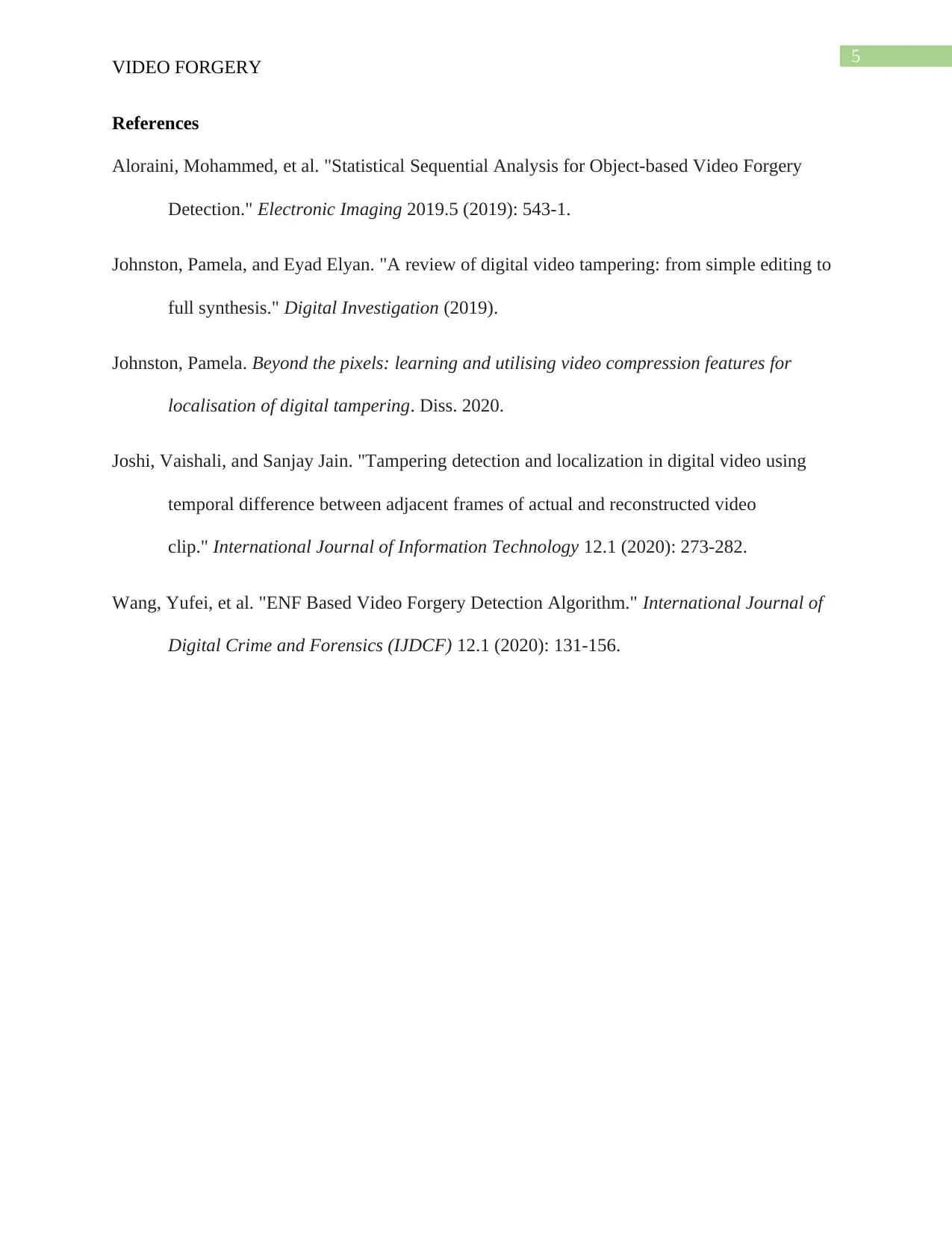
5
VIDEO FORGERY
References
Aloraini, Mohammed, et al. "Statistical Sequential Analysis for Object-based Video Forgery
Detection." Electronic Imaging 2019.5 (2019): 543-1.
Johnston, Pamela, and Eyad Elyan. "A review of digital video tampering: from simple editing to
full synthesis." Digital Investigation (2019).
Johnston, Pamela. Beyond the pixels: learning and utilising video compression features for
localisation of digital tampering. Diss. 2020.
Joshi, Vaishali, and Sanjay Jain. "Tampering detection and localization in digital video using
temporal difference between adjacent frames of actual and reconstructed video
clip." International Journal of Information Technology 12.1 (2020): 273-282.
Wang, Yufei, et al. "ENF Based Video Forgery Detection Algorithm." International Journal of
Digital Crime and Forensics (IJDCF) 12.1 (2020): 131-156.
VIDEO FORGERY
References
Aloraini, Mohammed, et al. "Statistical Sequential Analysis for Object-based Video Forgery
Detection." Electronic Imaging 2019.5 (2019): 543-1.
Johnston, Pamela, and Eyad Elyan. "A review of digital video tampering: from simple editing to
full synthesis." Digital Investigation (2019).
Johnston, Pamela. Beyond the pixels: learning and utilising video compression features for
localisation of digital tampering. Diss. 2020.
Joshi, Vaishali, and Sanjay Jain. "Tampering detection and localization in digital video using
temporal difference between adjacent frames of actual and reconstructed video
clip." International Journal of Information Technology 12.1 (2020): 273-282.
Wang, Yufei, et al. "ENF Based Video Forgery Detection Algorithm." International Journal of
Digital Crime and Forensics (IJDCF) 12.1 (2020): 131-156.
⊘ This is a preview!⊘
Do you want full access?
Subscribe today to unlock all pages.

Trusted by 1+ million students worldwide
1 out of 6
Related Documents
Your All-in-One AI-Powered Toolkit for Academic Success.
+13062052269
info@desklib.com
Available 24*7 on WhatsApp / Email
![[object Object]](/_next/static/media/star-bottom.7253800d.svg)
Unlock your academic potential
Copyright © 2020–2025 A2Z Services. All Rights Reserved. Developed and managed by ZUCOL.




